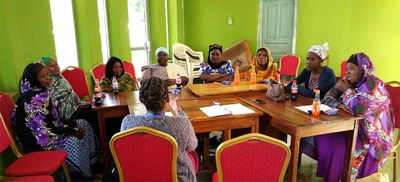Deep Dive into Qualitative Data Gathering
By Brittany Iskarpatyoti, MPH, Data for Impact (D4I), University of North Carolina at Chapel Hill
 When you drop a rock into a pool of water, how far do the ripples go? Do they roll out deliberately and gently, creeping to the edges of the water or do they form sharp ridges that quickly diffuse? As evaluators and programmers, we often ask a similar question—if we implement a program in a community, how far will the effects reverberate? What do those effects look like?
When you drop a rock into a pool of water, how far do the ripples go? Do they roll out deliberately and gently, creeping to the edges of the water or do they form sharp ridges that quickly diffuse? As evaluators and programmers, we often ask a similar question—if we implement a program in a community, how far will the effects reverberate? What do those effects look like?
Ripple effect mapping (REM) is a new method for international health research—innovative in its approach to rapid qualitative data collection and analysis. Data for Impact (D4I) is a new five-year project funded by the United States Agency for International Development (USAID) with a mandate to use innovative methods and existing data, where possible, to work with countries to generate evidence that will help improve health programs and outcomes. D4I’s leader award, MEASURE Evaluation (funded by USAID) has used REM in evaluations of health, education and governance programs including an evaluation of a systems-level public-sector strengthening project in Tanzania and in a program for orphans and vulnerable children and adolescents in Botswana.
Much like a traditional focus group discussion, REM convenes a group of stakeholders who have experienced a singular event, such as a training, or who have worked together on a project. Participants are asked to reflect on that event and share what they observed as effects. Unlike with traditional methods, in this process a facilitator then helps participants to “map” those experiences visually in real time. The facilitator encourages group members to contribute complementary or conflicting experiences, adding layers of context. The REM method invites all thinking from the group throughout the session and often sparks iterative and divergent observations. Participants are encouraged to keep thinking of every outcome or consequence they can imagine until all thoughts are mapped.
As we visualized what participants said, we found that we not only had the opportunity to immediately document the data, but also could clarify interpretations with participants at the moment of data collection, as well as engage them in multiple ways of thinking and processing—verbal and visual.
Once the “map” is done, participants reflect on what it might mean. What is most significant? What was expected and what was not? What could be added and what could be taken away? Further conversations might be held with different levels of participants—health system managers, clinicians, project implementers, and funders—each will have their own takeaways and insights.
In the international health research context, the REM method is time- and cost-efficient to implement and results and analysis are immediately available. Further analysis of maps and notes can inform and complement other types of data—such as was done in Tanzania, where REM data were used to complement key informant interviews and trends seen in routine health data.
These days, as countries and programs are looking for ways to use evidence for decision making but need results quickly, REM may be among the solutions that can perform rapidly without sacrificing quality.
Republished with permission from Science Speaks.












